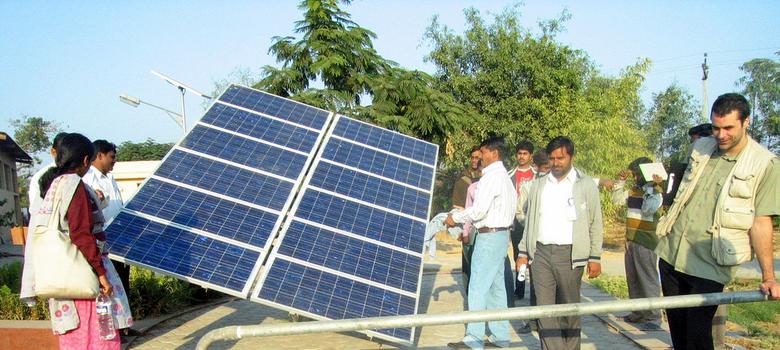Solar water pumps are being perceived as a boon for India’s farmers, most of whom depend on erratic power supply from an over-burdened power grid to draw water using electric pumps. But policy analysts also worry that the proliferation of solar pumps can dry out the water table.
Farmers, who so far have had to depend on undependable electricity supplied at night, will get full-voltage daytime power from solar panels and will extract more water and at a faster clip. State governments are not paying enough attention to this threat, worries Tushaar Shah, senior fellow at the International Water Management Institute in Colombo. The only way to counter this threat, Shah reasons in a paper published in Economic & Political Weekly, is to treat solar power as a cash crop and let farmers sell power back to the grid. The Karnataka state government has made a move in this direction.
Overexploited reserves
Like much of western India, Karnataka’s groundwater situation is dire, often teetering on the brink of crisis. In its last estimation in 2011, the Central Ground Water Board found that out of the 176 blocks, 35 are overexploited. In these blocks, the groundwater withdrawal has exceeded the amount of water available during the year. Another 20% of the land area has been categorised as critical and semi-critical, where more than 90% of the ground water reserves are drawn every year.
In Karnataka, Andhra Pradesh and Tamil Nadu, farmers get electricity free or at heavily subsidised rates, but distribution companies fail to provide electricity round-the-clock and at a steady voltage. As a result, farmers overcompensate when they do have power supply, explains Shah. “The farmer’s reaction has been to include auto switches,” Shah said. “Whenever power supply comes, the tubewell switches on automatically. So, irrespective of whether there is a need or not, the farmer keeps on pumping water because to him there is no cost. Also, whenever water supply is uncertain, farmers tend to over-irrigate.”
Incentivise, not penalise
Central Ground Water Board officials are now rushing in with damage control measures in the 35 overexploited blocks in Karnataka. “We have notified 35 blocks for regulation,” said K R Suryanarayana, a scientist with the board. “But regulation needs a lot of action, manpower and logistics. So it is still picking up.”
Shah has another solution. “The only way to control groundwater depletion is to incentivise farmers to conserve water,” he said. “You cannot penalise them.” Shah believes that Karnataka's Surya Raitha scheme, if implemented correctly, will do just that. Under the Surya Raitha policy, the state government is offering a 90% subsidy to farmers who want to buy a solar-powered irrigation pump set. It is also offering to buy electricity back from the farmers at a rate of Rs 7.5-9 and feed it into the power grid.
Value addition
On a sunny day, which Karnataka has in plenty, a typical 10 kilowatt solar pump can deliver full-voltage, uninterrupted power between 9 am and 4 pm. Shah estimates that this is more than enough for a farmer to water four acres of land and still generate enough power to sell it back to the grid. At the rates that the Karnataka government is offering under the new policy, farmers can make as much as Rs 60,000 annually just from the sale of power.
Shah calculates that the current tariffs offered under Surya Raitha makes solar irrigation pumps such an attractive prospect that the scheme will eventually become unsustainable. He suggests that the government give farmers a flat rate subsidy of Rs 40,000-Rs 50,000 instead of offering to pay 90% of the solar pump cost. He would also like the state to pay farmers Rs 5 per unit of electricity rather than the current higher rate. This is crucial, he feels, for striking a balance where farmers continue with the important agricultural activity rather than convert all their land into solar farms.
“Until 2013, there were only 7,000 pumps in India,” said Shah. “In just one year, the number of solar pumps in the field has increased by 20,000 pumps. So it is a new revolution. We are at a tipping point. If we do not create incentives for farmers to conserve solar energy and sell it to the grid, all the solar energy will be used to pump groundwater.”










